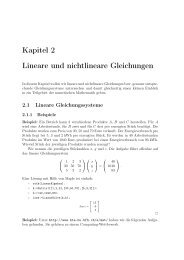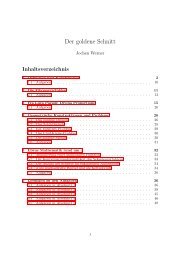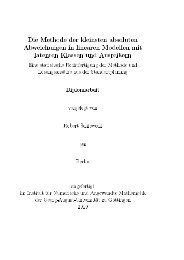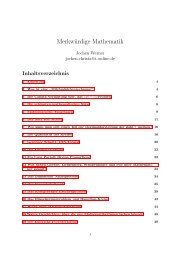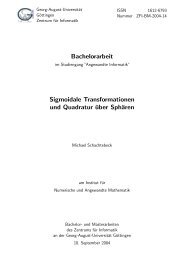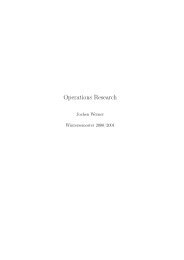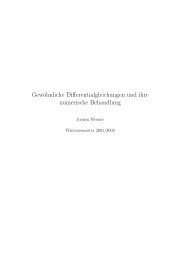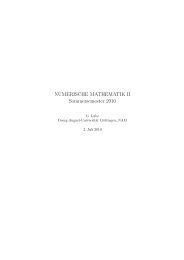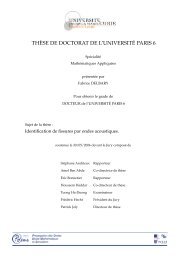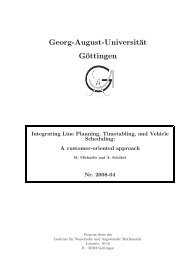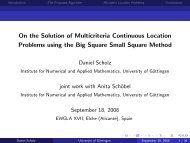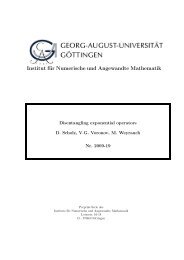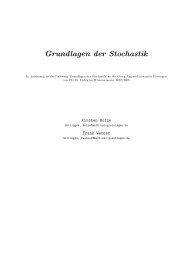BAIL 2006 Book of Abstracts - Institut für Numerische und ...
BAIL 2006 Book of Abstracts - Institut für Numerische und ...
BAIL 2006 Book of Abstracts - Institut für Numerische und ...
Create successful ePaper yourself
Turn your PDF publications into a flip-book with our unique Google optimized e-Paper software.
H. WANG: A Component-Based Eulerian-Lagrangian Formulation for Compositional<br />
Flow in Porous Media<br />
✬<br />
✫<br />
A Component-Based Eulerian-Lagrangian Formulation<br />
for Compositional Flow in Porous Media<br />
Hong Wang ∗<br />
Introduction Compositional models describe the simultaneous transport <strong>of</strong> multiple components<br />
flowing in coexisting phases in porous media [1, 4]. Because each component can transfer<br />
between different phases, the mass <strong>of</strong> each phase or a component within a particular phase is<br />
no longer conserved. Instead, the total mass <strong>of</strong> each component among all the phases must be<br />
conserved, leading to strongly coupled systems <strong>of</strong> transient nonlinear advection-diffusion equations.<br />
These equations are closely coupled to a set <strong>of</strong> constraining equations, which are strongly<br />
nonlinear, implicit functions <strong>of</strong> phase pressure, temperature, and composition. These equations<br />
need to be solved in all spatial cells at each iterative step <strong>of</strong> each time step via thermodynamic<br />
flash calculation. In industrial applications, upwind methods have commonly been used to stabilize<br />
the numerical approximations [1, 4]. However, these methods <strong>of</strong>ten generate excessive<br />
numerical dispersion and serious spurious effects due to grid orientation.<br />
Eulerian-Lagrangian methods symmetrize the transport equations and generate accurate<br />
numerical solutions even if large time steps and coarse spatial grids are used. They have demonstrated<br />
excellent performance in the numerical simulations <strong>of</strong> single-phase flow [3, 5] and immiscible<br />
two phase flow [2]. However, there exist serious mathematical and numerical difficulties in<br />
the development <strong>of</strong> Eulerian-Lagrangian methods for multiphase multicomponent compositional<br />
flow. We present a component-based Eulerian-Lagrangian formulation for compositional flow,<br />
which can be used by many Eulerian-Lagrangian methods.<br />
Numerical experiments We simulate the transport <strong>of</strong> Methane, Propane, and n-Hexane,<br />
flowing in coexisting liquid and vapor phases in a horizontal porous medium reservoir Ω =<br />
(0, 1000) × (0, 1000) ft 2 with a thickness <strong>of</strong> 1 ft over a time period <strong>of</strong> 20 years. An injection well<br />
is located at the upper-right corner <strong>of</strong> Ω with a volumetric injection rate <strong>of</strong> Q =15ft 3 /day. A<br />
production well is located at the lower-left corner with a production rate <strong>of</strong> Q = −15 ft 3 /day.<br />
The porosity φ = 0.1. The permeability is 60 md. The effect <strong>of</strong> capillary pressure is neglected.<br />
The relative permeability k r,l =(s l ) 2 and k r,v =(1−s l ) 2 . The initial reservoir pressure is 2100<br />
psia and the reservoir temperature is 350 o K. The composition <strong>of</strong> the resident fluid is cMethane<br />
= 0.5, cP ropane =0.2, and cn−Hexane =0.3, which is in liquid phase at the given temperature<br />
and pressure. The composition <strong>of</strong> the injected fluid is ¯cMethane = 0.8, ¯cP ropane =0.15, and<br />
¯cn−Hexane =0.05, which is in vapor phase.<br />
We use a uniform coarse spatial grid <strong>of</strong> ∆x =∆y= 25 ft. We use a time step <strong>of</strong> ∆tel =1<br />
year for the Eulerian-Lagrangian method, and <strong>of</strong> ∆tup = 2 days for the upwind method that is<br />
the largest possible. In Figure 1(a) we present the plots <strong>of</strong> the overall mole fraction cMethane<br />
generated by the Eulerian-Lagrangian method at t = 5 and 20 years. In Figure 1(b) we present<br />
the plots <strong>of</strong> the normalized molar amount n v Methane = ρv s v c v Methane /(ρ cMethane), where ρ v and<br />
sv are density and saturation <strong>of</strong> the vapor phase and ρ is bulk molar density <strong>of</strong> the fluid mixture.<br />
Note that nv i represents the fraction <strong>of</strong> ci in the vapor phase. Thus, nv i = 1 or 0 indicates that<br />
component i stays in the vapor phase or liquid phase completely. 0



